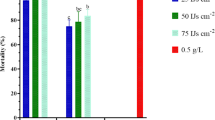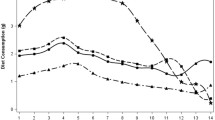Abstract
Halyomorpha halys (Stål) (Hemiptera: Pentatomidae) is becoming a major pest of Greece’s agricultural production, including tree fruit. Until now, the control of this pest has been based on conventional methods, with the application of chemical insecticides being the primary option. However, the wide distribution of H. halys, in combination with the large area of tree fruit production in Greece, raise the need for alternative control methods. In this study, we investigated the possibility of implementing microbial control agents for managing H. halys. Eggs and nymphs of H. halys were treated with 15 native entomopathogenic fungal isolates and their virulence was evaluated in the laboratory. After treatment, egg hatching time was recorded for 7 days and ranged from 4.5 to 7.0 days. Nymphal survival was recorded daily for 7 days following application and ranged from 2.1 to 6.6 days for second instar nymphs and 3.7 to 6.8 days for fourth instar ones. Beauveria varroae isolate displayed the highest toxicity to all H. halys stages that were tested and could be considered a promising biocontrol agent of this insect. Please check and confirm that the authors and their respective affiliations have been correctly identified and amend if necessary.οκ



Similar content being viewed by others
Data Availability
All data generated or analysed during this study are included in this manuscript.
References
Milonas PG, Partsinevelos GK (2014) First report of brown marmorated stink bug Halyomorpha halys Stål (Hemiptera: Pentatomidae) in Greece. EPPO Bull 44:183–186. https://doi.org/10.1111/epp.12129
Andreadis SS, Navrozidis EI, Farmakis A, Pisalidis A (2018) First evidence of Halyomorpha halys (Hemiptera: Pentatomidae) Infesting Kiwi Fruit (Actinidia chinensis) in Greece 1. J Entomol Sci 53:402–405. https://doi.org/10.18474/JES18-19.1
Leskey TC, Hamilton GC, Nielsen AL, et al (2012) Pest Status of the Brown Marmorated Stink Bug, Halyomorpha Halys in the USA. outlook pest man 23:218–226. https://doi.org/10.1564/23oct07
Rice KB, Bergh CJ, Bergmann EJ et al (2014) biology, ecology, and management of brown marmorated stink bug (Hemiptera: Pentatomidae). J Integ Pest Manage 5:1–13. https://doi.org/10.1603/IPM14002
Cesari M, Maistrello L, Ganzerli F et al (2015) A pest alien invasion in progress: potential pathways of origin of the brown marmorated stink bug Halyomorpha halys populations in Italy. J Pest Sci 88:1–7. https://doi.org/10.1007/s10340-014-0634-y
Bariselli M, Bugiani R, Maistrello L (2016) Distribution and damage caused by Halyomorpha halys in Italy. EPPO Bull 46:332–334. https://doi.org/10.1111/epp.12289
Kriticos DJ, Kean JM, Phillips CB et al (2017) The potential global distribution of the brown marmorated stink bug, Halyomorpha halys, a critical threat to plant biosecurity. J Pest Sci 90:1033–1043. https://doi.org/10.1007/s10340-017-0869-5
Lee D-H, Leskey TC (2015) Flight behavior of foraging and overwintering brown marmorated stink bug, Halyomorpha halys (Hemiptera: Pentatomidae). Bull Entomol Res 105:566–573. https://doi.org/10.1017/S0007485315000462
Wiman NG, Walton VM, Shearer PW et al (2015) Factors affecting flight capacity of brown marmorated stink bug, Halyomorpha halys (Hemiptera: Pentatomidae). J Pest Sci 88:37–47. https://doi.org/10.1007/s10340-014-0582-6
Leskey TC, Nielsen AL (2018) Impact of the Invasive Brown Marmorated Stink Bug in North America and Europe: history, biology, ecology, and management. Annu Rev Entomol 63:599–618. https://doi.org/10.1146/annurev-ento-020117-043226
Sakai AK, Allendorf FW, Holt JS et al (2001) The population biology of invasive species. Annu Rev Ecol Syst 32:305–332. https://doi.org/10.1146/annurev.ecolsys.32.081501.114037
Kuhar TP, Kamminga K (2017) Review of the chemical control research on Halyomorpha halys in the USA. J Pest Sci 90:1021–1031. https://doi.org/10.1007/s10340-017-0859-7
Bergmann EJ, Raupp MJ (2014) Efficacies of common ready to use insecticides against Halyomorpha halys (Hemiptera: Pentatomidae). Florida Entomologist 97:791–800. https://doi.org/10.1653/024.097.0262
Lee D-H, Short BD, Nielsen AL, Leskey TC (2014) Impact of organic insecticides on the survivorship and mobility of Halyomorpha halys (Stål) (Hemiptera: Pentatomidae) in the laboratory. Florida Entomologist 97:414–421. https://doi.org/10.1653/024.097.0211
Leskey TC, Short BD, Lee D-H (2014) Efficacy of insecticide residues on adult Halyomorpha halys (Stål) (Hemiptera: Pentatomidae) mortality and injury in apple and peach orchards: Residual insecticide efficacy on Halyomorpha halys. Pest Manag Sci 70:1097–1104. https://doi.org/10.1002/ps.3653
Nielsen AL, Shearer PW, Hamilton GC (2008) Toxicity of insecticides to Halyomorpha halys (Hemiptera: Pentatomidae) using glass-vial bioassays. J Econ Entomol 101:1439–1442
Leger RJ, Frank DC, Roberts DW, Staples RC (1992) Molecular cloning and regulatory analysis of the cuticle-degrading-protease structural gene from the entomopathogenic fungus Metarhizium anisopliae. Eur J Biochem 204:991–1001. https://doi.org/10.1111/j.1432-1033.1992.tb16721.x
Kumar SS (2017) Effect of entomopathogenic fungi on the food consumption of acrididae species. Int J Agric Biol Eng INT J AGR BIOL ENG 11:408–412
Tozlu E, Saruhan I, Tozlu G et al (2019) Potentials of some entomopathogens against the brown marmorated stink bug, Halyomorpha halys (Stål, 1855) (Hemiptera: Pentatomidae). Egypt J Biol Pest Control 29:76. https://doi.org/10.1186/s41938-019-0176-y
Sosa-Gómez DR, Moscardi F (1998) Laboratory and field studies on the infection of stink bugs, Nezara viridula, Piezodorus guildinii, and Euschistus heros (Hemiptera: Pentatomidae) with Metarhizium anisopliae and Beauveria bassiana in Brazil. J Invertebr Pathol 71:115–120. https://doi.org/10.1006/jipa.1997.4716
Ihara F, Toyama M, Mishiro K, Yaginuma K (2008) Laboratory studies on the infection of stink bugs with Metarhizium anisopliae strain FRM515. Appl Entomol Zool 43:503–509
Gouli V, Gouli S, Skinner M et al (2012) Virulence of select entomopathogenic fungi to the brown marmorated stink bug, Halyomorpha halys (Stål) (Heteroptera: Pentatomidae): Virulence of entomopathogenic fungi to H. halys. Pest Manag Sci 68:155–157. https://doi.org/10.1002/ps.2310
Parker B, Skinner M, Gouli S et al (2015) Virulence of BotaniGard® to second instar brown marmorated stink bug, Halyomorpha halys (Stål) (Heteroptera: Pentatomidae). Insects 6:319–324. https://doi.org/10.3390/insects6020319
Quesada-Moraga E, Navas-Cortés JA, Maranhao EAA et al (2007) Factors affecting the occurrence and distribution of entomopathogenic fungi in natural and cultivated soils. Mycol Res 111:947–966. https://doi.org/10.1016/j.mycres.2007.06.006
Mantzoukas S, Lagogiannis I, Mpekiri M et al (2019) Insecticidal action of several isolates of entomopathogenic fungi against the granary weevil Sitophilus granarius. Agriculture 9:222. https://doi.org/10.3390/agriculture9100222
Rogers SO, Bendich AJ (1985) Extraction of DNA from milligram amounts of fresh, herbarium and mummified plant tissues. Plant Mol Biol 5:69–76. https://doi.org/10.1007/BF00020088
Andreadis SS, Moysiadis T, Gogolashvili NE et al (2022) Quality degradation of industrial hemp due to infestation by Halyomorpha halys (Hemiptera: Pentatomidae). Int J Pest Manage. https://doi.org/10.1080/09670874.2022.2089769
Fernandes ÉKK, Rangel DEN, Moraes ÁML et al (2008) Cold activity of beauveria and metarhizium, and thermotolerance of Beauveria. J Invertebr Pathol 98:69–78. https://doi.org/10.1016/j.jip.2007.10.011
Mantzoukas Zikou, Triantafillou, et al (2019) Ιnteractions between Beauveria bassiana and Isaria fumosorosea and their hosts Sitophilus granarius (L.) and Sitophilus oryzae (L.) (Coleoptera: Curculionidae). Insects 10:362. https://doi.org/10.3390/insects10100362
Fargues J, Goettel MS, Smits N et al (1996) Variability in susceptibility to simulated sunlight of conidia among isolates of entomopathogenic Hyphomycetes. Mycopathologia 135:171–181. https://doi.org/10.1007/BF00632339
Rehner SA, Buckley E (2005) A Beauveria phylogeny inferred from nuclear ITS and EF1- sequences: evidence for cryptic diversification and links to Cordyceps teleomorphs. Mycologia 97:84–98. https://doi.org/10.3852/mycologia.97.1.84
Driver F, Milner RJ, Trueman JWH (2000) A taxonomic revision of Metarhizium based on a phylogenetic analysis of rDNA sequence data. Mycol Res 104:134–150. https://doi.org/10.1017/S0953756299001756
Pantou MP, Mavridou A, Typas MA (2003) IGS sequence variation, group-I introns and the complete nuclear ribosomal DNA of the entomopathogenic fungus Metarhizium: excellent tools for isolate detection and phylogenetic analysis. Fungal Genet Biol 38:159–174. https://doi.org/10.1016/S1087-1845(02)00536-4
Moino A, Alves SB, Pereira RM (1998) Efficacy of Beauveria bassiana (Balsamo) Vuillemin isolates for control of stored-grain pests. J Appl Entomol 122:301–305. https://doi.org/10.1111/j.1439-0418.1998.tb01501.x
Dal Bello G, Padin S, López Lastra C, Fabrizio M (2000) Laboratory evaluation of chemical-biological control of the rice weevil (Sitophilus oryzae L.) in stored grains. J Stored Prod Res 37:77–84. https://doi.org/10.1016/S0022-474X(00)00009-6
Cherry AJ, Abalo P, Hell K (2005) A laboratory assessment of the potential of different strains of the entomopathogenic fungi Beauveria bassiana (Balsamo) Vuillemin and Metarhizium anisopliae (Metschnikoff) to control Callosobruchus maculatus (F.) (Coleoptera: Bruchidae) in stored cowpea. J Stored Products Res 41:295–309
Wakefield ME, Cox PD, Aquino De Muro M, Bell BA (2005) Mycopest: Results and perspectives. In: 6th Meeting of COST Action 842 Working Group IV, Biocontrol of Arthropod Pests in Stored Products. Locorotondo, pp. 17–26
Sasaki F, Miyamoto T, Yamamoto A et al (2012) Relationship between intraspecific variations and host insects of Ophiocordyceps nutans collected in Japan. Mycoscience 53:85–91. https://doi.org/10.1007/S10267-011-0137-0
Bateman R, Carey M, Batt D et al (1996) Screening for virulent isolates of entomopathogenic fungi against the desert Locust, Schistocerca gregaria Forskal. Biocontrol Sci Tech 6:549–560. https://doi.org/10.1080/09583159631181
Gundannavar KP, Giraddi RS, Kulkarni KA, Awaknavar JS (2007) Development of integrated pest management modules for chilli pests. Karnataka J Agric Sci 20:757–760
Fargues J, Goettel MS, Smits N et al (1997) Effect of temperature on vegetative growth of Beauveria bassiana isolates from different origins. Mycologia 89:383–392. https://doi.org/10.1080/00275514.1997.12026797
Andreadis SS, Cloonan KR, Bellicanta GS et al (2016) Efficacy of Beauveria bassiana formulations against the fungus gnat Lycoriella ingenua. Biol Control 103:165–171. https://doi.org/10.1016/j.biocontrol.2016.09.003
Andreadis SS, Cloonan KR, Bellicanta GS, Jenkins NE (2021) Efficacy of BotaniGard ® against the mushroom phorid fly Megaselia halterata. Biocontrol Sci Tech 31:1098–1106. https://doi.org/10.1080/09583157.2021.1926427
Acknowledgements
This research was funded by the Operational Programme Competitiveness, Entrepreneur- ship, and Innovation, 2014–2020 (EPAnEK), under the call “Research-Create-Innovate”.
Funding
This research was funded by the Operational Programme Competitiveness, Entrepreneur- ship, and Innovation, 2014–2020 (EPAnEK), under the call “Research-Create-Innovate”.
Author information
Authors and Affiliations
Contributions
This work was carried out in collaboration among all authors. SM, EIN, TT and SSA designed the study. EIK, NG and IL performed the laboratory experiments. SM, EIN, TT and SSA produced the manuscript. SM, EIN, TT and SSA revised the manuscript. SM, EIN, TT and SSA managed the literature searches. All authors contributed to revisions of the article. All authors read and approved the final manuscript.
Corresponding authors
Ethics declarations
Conflict of interest
The authors declare no conflict of interest.
Ethical Approval
Not applicable.
Consent to Participate
Not applicable.
Consent for Publication
Not applicable.
Additional information
Publisher's Note
Springer Nature remains neutral with regard to jurisdictional claims in published maps and institutional affiliations.
Supplementary Information
Below is the link to the electronic supplementary material.
Rights and permissions
Springer Nature or its licensor (e.g. a society or other partner) holds exclusive rights to this article under a publishing agreement with the author(s) or other rightsholder(s); author self-archiving of the accepted manuscript version of this article is solely governed by the terms of such publishing agreement and applicable law.
About this article
Cite this article
Mantzoukas, S., Koutsogeorgiou, E.I., Lagogiannis, I. et al. Effect of Entomopathogenic Fungi to Eggs and Nymphs Survival of Halyomorpha halys (Hemiptera: Pentatomidae) Under Laboratory Conditions. Curr Microbiol 81, 48 (2024). https://doi.org/10.1007/s00284-023-03547-y
Received:
Accepted:
Published:
DOI: https://doi.org/10.1007/s00284-023-03547-y




